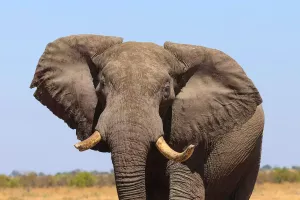The name of the serval comes from Spanish, which means "wolf like a deer", and it is not difficult to understand through the meaning. From the outside, the serval has a wild feel, and because of this appearance, it also makes it a valuable breed.
The serval is a medium-sized cat native to Africa, weighing 12-30 kilograms, which is equivalent to the weight of a medium-sized dog. In the United States and other countries and regions, servals are kept as pets, and the price is very expensive. The most common servals cost more than 60,000 US dollars, and the champion-level purebred servals that have won awards can even sell for hundreds of thousands of dollars. In addition, because of its spirituality and noble temperament, the serval is favored by the Italian Tomasi family and has become a family totem.
The serval has a slender trunk and limbs. The coat is yellow with dark spots that merge with the longitudinal markings on the back and head. There are several black rings on the tail, and the tip of the tail is black. Males are usually larger than females. Compared with other cats, they are more slender in size, with long legs and short tails, and their ears are tall and rounded, and the bases of the ears are close together.
The main habitat of the serval is the African savannah, and sometimes in the mountains. Generally live in groups, with an average lifespan of 12-20 years. They are adapted to live in reeds on the edge of wetlands. Serval predators are basically rodents, but they also sometimes prey on hares, hyraxes, birds, reptiles, insects, fish and frogs. 93.5% of serval food is rodents, shrew and other animals, and birds account for 5% of the diet. Others include insects, frogs, lizards, etc.
They occasionally dive underwater to catch live fish. Rarely eating carrion, servals may prey on larger animals such as duikers, but 90% of their prey weighs no more than 200 grams. Servals help farmers hunt locusts and rodents, and rarely kill livestock. Because this species congregates near rivers, it is easily exposed and killed, and it is also at risk of habitat loss.
Servals give birth to 1-5 cubs per litter, with 2-3 cubs being the main ones. Litters generally use aardvark's burrows or open spaces under shrubs. Servals are sometimes preyed on by leopards, but their greatest threat comes from humans. Because of its beautiful and expensive fur, many people poach servals for it. The number of servals in West and East Africa is still relatively high, but the servals in South Africa and north of the Sahara Desert are very rare and endangered.
The trend of private breeding of servals originated in the Middle East. In recent years, more and more people have chosen to keep servals as pets. Domestic cats have been domesticated by humans for five thousand years. Even so, there is no guarantee that domestic cats will not attack humans.
The serval itself is a wild animal, and is a medium-sized cat, which is more aggressive. In addition, when institutions such as zoos introduce exotic creatures, they will go through multiple epidemic prevention inspection procedures, but the source of the servals sold by these private sellers is unclear and may contain epidemic diseases.
Before 2012, the minimum generation of hybrid servals (Savannah cats) allowed in the United States was F1, and the minimum generation of hybrid servals allowed in Europe was F2. But the so-called domestication is only one or two generations of artificial breeding to reduce the wildness of the serval, not the long-term domestication process like domestic cats, so there is a certain danger in personal breeding.


